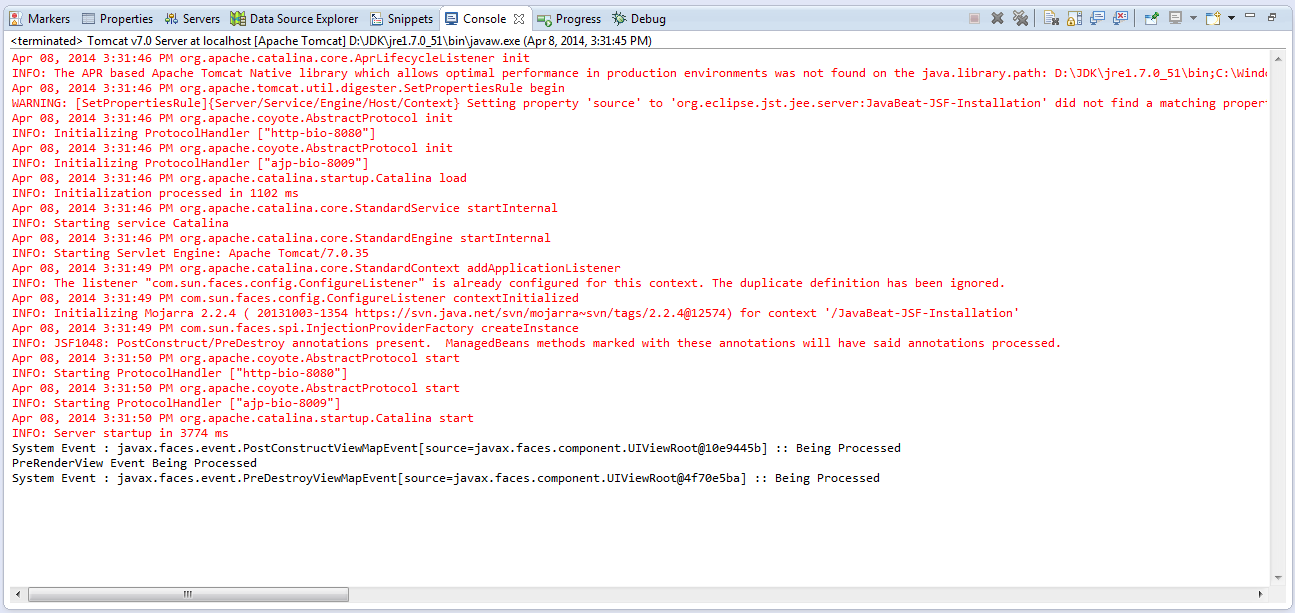As mentioned previously in the introduction of the JSF2 System Events – Application Events, there are many kinds of System events that could be listening for. UIViewRoot component – is the UIComponent that represents the root of the UIComponent tree – also does considered one of the component that has fired a system event.
UIViewRoot has fired three main types of events:
- PreRenderComponentEvent: This event has fired before the view root is about to be rendered.
- PostConstructiveMapEvent: This event has fired after the root component has constructed the view scope map
- PreDestroyViewMapEvent: This event has fired when the view map is cleaned.
Let’s see how could such those events listened.
1. ViewScoped Managed Bean
IndexBean.java
package net.javabeat.jsf;
import javax.faces.bean.ManagedBean;
import javax.faces.bean.ViewScoped;
import javax.faces.context.FacesContext;
import javax.faces.event.ComponentSystemEvent;
import javax.faces.event.PostConstructViewMapEvent;
import javax.faces.event.PreDestroyViewMapEvent;
@ManagedBean
@ViewScoped
public class IndexBean {
private UIViewRootListener listener = new UIViewRootListener();
public IndexBean(){
// Subscribe listener for PostConstructiveViewMapEvent
FacesContext.getCurrentInstance().getApplication().
subscribeToEvent(PostConstructViewMapEvent.class, listener);
// Subscribe listener for PreDestrotyViewMapEvent
FacesContext.getCurrentInstance().getApplication().
subscribeToEvent(PreDestroyViewMapEvent.class, listener);
}
private String message = "JavaBeat Message";
public String getMessage() {
return message;
}
public void setMessage(String message) {
this.message = message;
}
public void preRenderView(ComponentSystemEvent e){
System.out.println("PreRenderView Event Being Processed");
}
public String emptyViewScope(){
return "index";
}
}
2. UIViewRoot Event Listener
UIViewRootListener.java
package net.javabeat.jsf;
import javax.faces.component.UIViewRoot;
import javax.faces.event.AbortProcessingException;
import javax.faces.event.SystemEvent;
import javax.faces.event.SystemEventListener;
public class UIViewRootListener implements SystemEventListener{
public void processEvent(SystemEvent event) throws AbortProcessingException {
System.out.println("System Event : "+event.toString() + " :: Being Processed");
}
public boolean isListenerForSource(Object source) {
if(source instanceof UIViewRoot){
return true;
}
return false;
}
}
3. The Views
index.xhtml
<html xmlns="http://www.w3.org/1999/xhtml" xmlns:ui="http://java.sun.com/jsf/facelets" xmlns:h="http://java.sun.com/jsf/html" xmlns:f="http://java.sun.com/jsf/core"> <f:view> <h:form> <h1>JavaBeat JSF 2.2 Examples</h1> <h2>JSF2 System Events - Application Source Example</h2> <br/> <h2>This is a JSF View</h2> <h:commandButton value="Go To Anonymous View" action="anonymousView"></h:commandButton> </h:form> </f:view> </html>
anonymousView.xhtml
<html xmlns="http://www.w3.org/1999/xhtml"
xmlns:ui="http://java.sun.com/jsf/facelets"
xmlns:h="http://java.sun.com/jsf/html"
xmlns:f="http://java.sun.com/jsf/core">
<f:view>
<f:event listener="#{indexBean.preRenderView}" type="preRenderView"></f:event>
<h:form>
<h1>JavaBeat JSF 2.2 Examples</h1>
<h2>JSF2 System Events - Application Source Example</h2>
<br/>
<h3>View Map Constructed</h3>
<br/>
<h:outputText value="#{indexBean.message}"/>
<br/>
<h:commandButton value="Go To Index" action="index"></h:commandButton>
</h:form>
</f:view>
</html>
4. Faces Configuration File
faces-config.xml
<?xml version="1.0" encoding="UTF-8"?> <faces-config xmlns="http://xmlns.jcp.org/xml/ns/javaee" xmlns:xsi="http://www.w3.org/2001/XMLSchema-instance" xsi:schemaLocation="http://xmlns.jcp.org/xml/ns/javaee http://xmlns.jcp.org/xml/ns/javaee/web-facesconfig_2_2.xsd" version="2.2"> <application> <resource-bundle> <base-name>net.javabeat.jsf.application</base-name> <var>msg</var> </resource-bundle> </application> </faces-config>
5. The Deployment Descriptor
web.xml
<?xml version="1.0" encoding="UTF-8"?> <web-app xmlns:xsi="http://www.w3.org/2001/XMLSchema-instance" xmlns="http://java.sun.com/xml/ns/javaee" xmlns:web="http://java.sun.com/xml/ns/javaee/web-app_2_5.xsd" xsi:schemaLocation="http://java.sun.com/xml/ns/javaee http://java.sun.com/xml/ns/javaee/web-app_2_5.xsd" id="WebApp_ID" version="2.5" metadata-complete="true"> <context-param> <description>State saving method: 'client' or 'server' (=default). See JSF Specification 2.5.2 </description> <param-name>javax.faces.STATE_SAVING_METHOD</param-name> <param-value>server</param-value> </context-param> <context-param> <param-name>javax.faces.application.CONFIG_FILES</param-name> <param-value>/WEB-INF/faces-config.xml</param-value> </context-param> <servlet> <servlet-name>Faces Servlet</servlet-name> <servlet-class>javax.faces.webapp.FacesServlet</servlet-class> <load-on-startup>1</load-on-startup> </servlet> <servlet-mapping> <servlet-name>Faces Servlet</servlet-name> <url-pattern>/faces/*</url-pattern> </servlet-mapping> <servlet-mapping> <servlet-name>Faces Servlet</servlet-name> <url-pattern>*.xhtml</url-pattern> </servlet-mapping> <listener> <listener-class>com.sun.faces.config.ConfigureListener</listener-class> </listener> </web-app>
6. JSF 2 UIViewRoot Event Demo
The below snapshot shows you the normal behavior for listening upon UIViewRoot component events.

[wpdm_file id=53]

 JSF 2 SystemEventListener Example
JSF 2 SystemEventListener Example